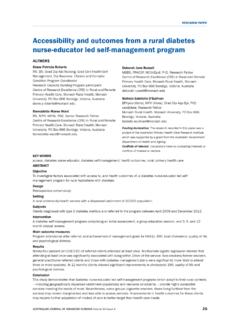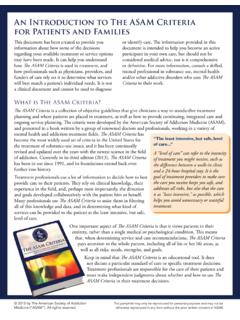Transcription of Guideline for the treatment and planning of services for ...
1 Guideline for the treatment and planning of services for complex post - traumatic stress disorder in adults 2 Authors Mark McFetridge, the Retreat York, UK Alison Hauenstein Swan, Institute of Psychotrauma, London Sarah Heke, Institute of Psychotrauma, London Thanos Karatzias, Edinburgh Napier University & NHS Lothian Rivers Centre for traumatic stress Neil Greenberg, King s College, London Neil Kitchiner, Veterans NHS Wales, Cardiff Rachel Morley, NHS Greater Glasgow & Clyde Board Members of the UK Psychological Trauma Society (UKPTS) 2014-2016 Published in February 2017 3 Table of contents Executive summary 4 The purpose of this Guideline 7 What is CPTSD? 8 The conceptual basis of effective therapy for CPTSD 12 Engagement and assessment 15 Phase 1: Stabilisation and psychoeducation 16 1. Establishing a therapeutic relationship 18 2. Psychoeducation 19 3.
2 Establishing safety and readiness for therapy 24 4. Grounding for dissociation and flashbacks 24 5. Symptom management 24 6. Skills training 26 7. Compassion-focused therapy 28 Phase 2: Trauma processing 29 1. Cognitive behavioural therapy approaches 30 2. Prolonged exposure: application and adaptions for CPTSD 32 2. Eye movement desensitisation and reprocessing 34 4. Narrative exposure therapy 37 Phase 3: Reintegration, reconnection and recovery 40 Biology and pharmacotherapy 42 Special considerations in treating CPTSD 43 The therapeutic relationship 43 Parenting 43 Therapist competency 43 Supervision 44 Vicarious traumatisation 44 Further research 45 Conclusions 45 References 48 Acknowledgements 61 Appendix 1: Initial client assessment proforma 62 Index 68 4 Executive summary complex post - traumatic stress disorder (CPTSD) has been recognised by clinicians working within the field for many years, notably since 1992 (Herman, 1992).
3 It has recently been proposed that CPTSD be included as a new diagnosis in ICD-11 (Maercker et al., 2013). Prevalence estimates for CPTSD range from per cent in a USA community sample to 13 per cent in a veteran sample (Wolf et al. 2015). In a treatment -seeking trauma clinic outpatient sample, per cent met the proposed ICD-11 criteria for CPTSD (Karatzias et al., 2016). The proposed ICD-11 diagnosis of post - traumatic stress disorder (PTSD) includes three clusters of symptoms: o re-experiencing of the trauma in the present o avoidance of traumatic reminders o a persistent sense of threat manifesting in increased arousal and hypervigilance. These symptoms define PTSD as a response characterised by some degree of fear or horror related to a specific traumatic event. The symptom profile of CPTSD includes these core PTSD symptoms, but in addition persistent and pervasive disturbances in self-organisation that describe impairments in regulating emotional experience, in sustaining relationships, and in the sense of self.
4 The latter may include beliefs about oneself as diminished, defeated or worthless (Maercker et al., 2013). Unlike PTSD, there are no current NICE (National Institute for Health and Care Excellence) guidelines on, or Cochrane review of, the effectiveness of psychological and pharmacological interventions for CPTSD in the UK. The Board of the UK Psychological Trauma Society (UKPTS), therefore, proposed a review of published evidence and accepted good clinical practice to develop a Guideline for those working clinically or planning services for people with CPTSD. This Guideline was developed in response to the forthcoming edition of ICD-11; CPTSD is not described in DSM-5 (American Psychiatric Association, 2013) and, furthermore, not all 5 traumatic responses are accounted for by the DSM-5 PTSD criteria. The Guideline reflects the current state of evidence regarding the treatment of CPTSD following exposure to traumatic stressors.
5 Following the publication of ICD-11 we anticipate significantly more published research on the treatment of CPTSD. The UKPTS intends to update this Guideline as further evidence becomes available. There is debate in the literature about whether CPTSD shares common characteristics with other conditions including borderline personality disorder (BPD), emotionally unstable personality disorder, dissociative disorders , and medically unexplained symptoms. There is, however, emerging evidence to suggest that CPTSD presents with many distinctive features, including a lower risk of both self-harm and fear of abandonment, and a more stable negative sense of self than BPD. Whilst studies suggest comorbidity is high, not all individuals with BPD or severe dissociative disorders report a history of formal traumatic experience(s), which is clearly required for CPTSD (Cloitre et al., 2014). A psychological formulation is a more flexible approach for conceptualising people experiencing any of these difficulties, and more able to incorporate additional systemic and attachment factors.
6 Research has found CPTSD to be associated with structural and functional changes in the emotional centres of the brain (limbic system), and with significantly impaired emotional, interpersonal and occupational functioning (van der Kolk, 2014). Repeated childhood trauma is closely correlated with increased physical and mental health difficulties, as well as a significantly greater likelihood of social and forensic problems (Felitti et al., 1998). CPTSD has been found to be associated with more frequent and a greater accumulation of different types of childhood traumatic experiences, and with poorer functional impairment (Karatzias et al., 2016). Evidence suggests that therapeutic input (psychological, social and pharmacological) may be able to ameliorate some, or all, of the consequences of complex traumatisation. Whilst there is an on-going debate about whether a stabilisation phase is necessary or may represent an unhelpful delay, most published studies in 6 complex trauma have used a phase-based approach to treatment .
7 There is significant variation between studies in the duration and content of the phases. In clinical practice the phases can be tailored to individual need, taking account of the individual risk behaviours and capacity to tolerate emotional distress within psychological therapy. Indeed, most treatment of non- complex PTSD is also likely to include an element of stabilisation even if carried out briefly during the initial therapeutic contact. The phase-based model, originally proposed by Herman (1992), involves three overlapping phases of treatment , which may be cyclical. The individual may need to return to earlier phases as therapy progresses: o Phase one: stabilisation (establishing safety, symptom management, improving emotion regulation and addressing current stressors) o Phase two: trauma processing (focused processing of traumatic memories) o Phase three: reintegration (re-establishing social and cultural connection and addressing personal quality of life).
8 The most effective trauma-focused therapy for the treatment of CPTSD is unknown. There is currently insufficient evidence to recommend any particular therapy over another, but in accordance with the general literature on the impact of post - traumatic stress , it is generally agreed that treatment needs to address three domains: cognitive, affective and sensorimotor. Trauma-focused therapy should not be unnecessarily delayed or avoided, but it is equally important that it be considered in light of recent risk behaviours and the individual s presentation. Most trauma-focused therapies incorporate exposure elements with varying levels of intensity. Clinicians should proceed with caution when applying therapies with exposure elements to patients with CPTSD and apply them in an individualised and incremental way. Where there has been recent self-harming or parasuicidal behaviour the clinician should act with due 7 consideration of safety (and potential effectiveness) and include a stabilisation and psychoeducation phase.
9 A number of existing effective therapies for PTSD have been adapted for phase 2 (trauma processing) of CPTSD, including prolonged exposure and eye movement desensitisation and reprocessing (EMDR). Other therapeutic approaches such as narrative exposure therapy (NET), compassion-focused therapy, dialectical behaviour therapy, and the therapeutic community, may be helpful with some or all phases. Untreated CPTSD is often a chronic problem, but a meta-analysis of randomised controlled trials (RCTs) of psychological therapies for adult survivors of childhood sexual abuse found psychological therapies to be effective (Ehring et al., 2014). The UKPTS considers that failure to address CPTSD in the UK population will continue to cause intergenerational health consequences and incur considerable social and economic costs for the UK. Successfully addressing CPTSD also accords with the UK priorities of working with survivors of interpersonal trauma including childhood sexual abuse, reducing the negative health inequalities associated with adverse childhood experiences and reducing suicide.
10 The purpose of this Guideline This document has been produced by the UK Psychological Trauma Society (UKPTS) as a guide for healthcare professionals, commissioners and those tasked with the strategic planning of adult mental health services . People with lived experience of complex post - traumatic stress disorder (CPTSD) reviewed earlier drafts of the Guideline and helped shape its final content. Service planning for CPTSD should take place within the wider context of trauma-informed care (Bassuk et al., 2016). The UKPTS recognises that complex traumatic experiences of repeated violence and abuse often occur in the context of situations of inequality, including gender and ethnic inequality, and can lead to further health and social disadvantages. There is a need for responses at many levels including trauma prevention, psychosocial interventions and 8 sociopolitical responses. However, these guidelines focus only on clinical treatment .









